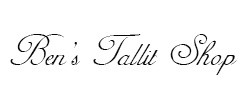Usually when a customer wants to buy tallit and tefillin, it's for a almost 12-year-old heading for his bar mitzvah, but this week we got a tallit and tefillin inquiry from a groom whose life is shifting: now only is he headed toward married life, but he also seems to be becoming observant -- at his own pace. He contact me with a lot of questions on how to choose the right tallit and which tefillin to buy.
Hello,
Since I’m getting married on the 6th of
Elul and as being of Ashkenazi descendant I am looking for a tallit for
myself and my fiancée asked me to gather some information. Since I currently have no tallit, I have no experience in choosing
one. I would really appreciate your advice.
My goal is to find a high quality, traditional, black-striped tallit that I can use for decades. I’ve looked at the tallitot at your website and I think I will focus my interest on the following products:
- Hamefoar Prestige
- Echt Turkish
- Chatanim
Unfortunately I’m not completely sure of the differences. Echt Turkish
is not a non-slip tallit, right? What is the exact difference between
Chatanim and Hamefoar Tallit?
Despite the fact that I’m not fully a baal tshuva I still try to keep
the mitzvot to a high degree. Since I’m starting a family, I want to
start it right. That’s why I want to begin with the mitzva of
tefillin. In that field I would also appreciate your advice.
As with the tallit, I would prefer a set of tefillin that I can use for years to come
and that is halachically on an acceptable level. I am debating between Tefillin Dakkot Ohr Echad or Tefillin Gassot. As far as I understand
there is no halachic difference, the main point is the durability? What
is the difference between Elyon and Avodat Yad, black/tan and
black/black? Do you have any pictures of Avodat Yad, black/tan and
black/black straps? Do the tefillin come with cases?
Thank you in advance for your help and advice.
Kind regards,
Igor
- Echt Turkish - very thick and heavy, smooth fabric and thick, dark striping, interlaced fringes
- Chatanim - a high quality tallit with a standard weave
- Hamefoar Prestige - high quality nonslip tallit withcotton semi-lining and sidebands
- Hamefoar - very slightly lighter than Hamefoar Prestige and without the lining and sidebands
When you buy tefillin there are really two issue: the boxes and the parchments. The writing by the scribe on the parchments comes in many different levels of quality, from $100 or $150 to $400 or $600 or more (i.e. the value of the parchments, not what you pay for the end product). On the lower levels, to rule the writing is completely kosher, one has to rely on various halachic leniences. If you go up a bit in price, there are no longer halachic uncertainties about the writing, but aesthetically it may be mediocre. If you want kosher writing that is also very beautiful (even though you may never see the writing) you have to pay a lot of money.
Regarding the tefillin straps, the halacha states that the tefillin straps must be black on the side that shows. Until a few years ago, the bottom side of the tefillin straps were left the natural unfinished brown color. In recent years all-black straps are becoming more popular. I've attached photos of both. Note that the black/black option is only available with Avodat Yad straps.
Elyon straps are middle-grade (low grade tefillin straps are called shpalt). Avodat Yad are made by hand from start to finish, to eliminate halachic concerns. Various mitzvah objects (e.g. tefillin, tzitzit strings, matzah) must be made with mitzvah intention from an early stage in the production process. Machine matzah, machine-spun tzitzit and elyon tefillin straps require applying halachic leniencies.
 United States Dollar
United States Dollar
 Shekel
Shekel
 Euro
Euro
 British Pound
British Pound
 Australian Dollar
Australian Dollar
 New Zealand Dollar
New Zealand Dollar
 Canadian Dollar
Canadian Dollar
